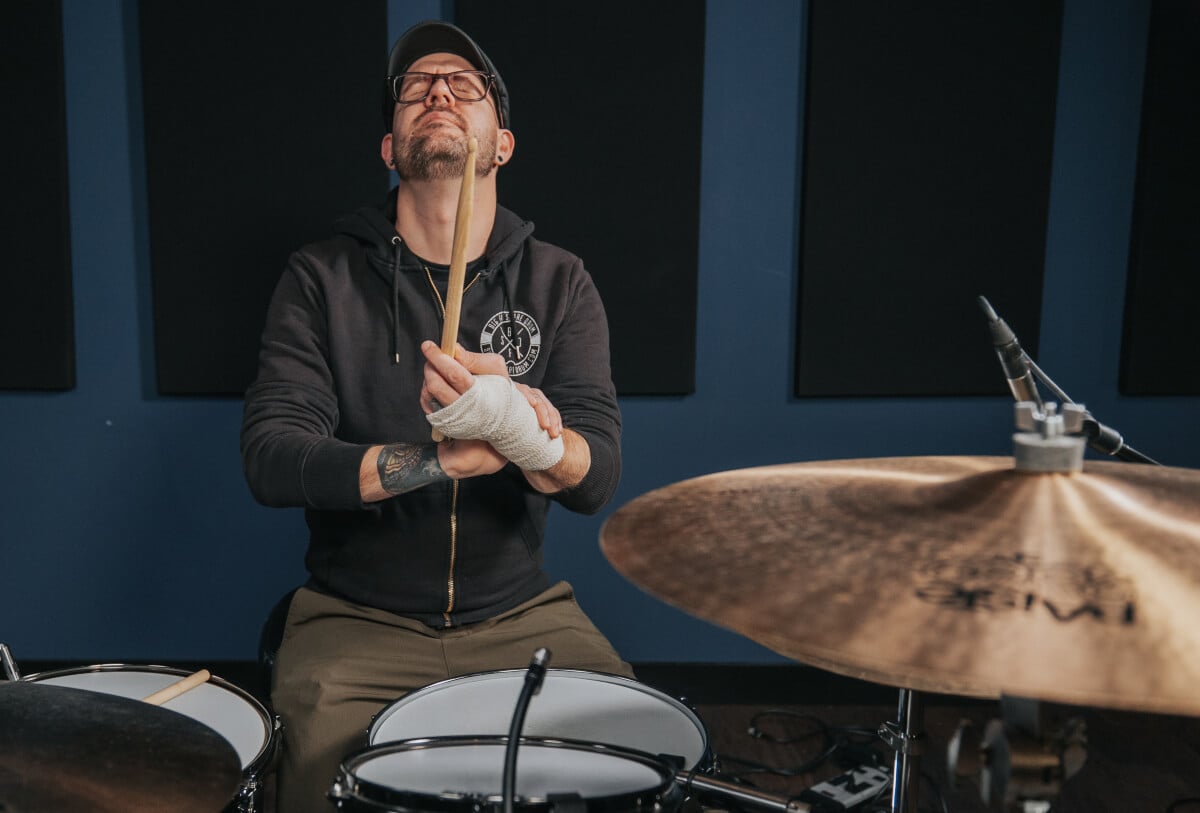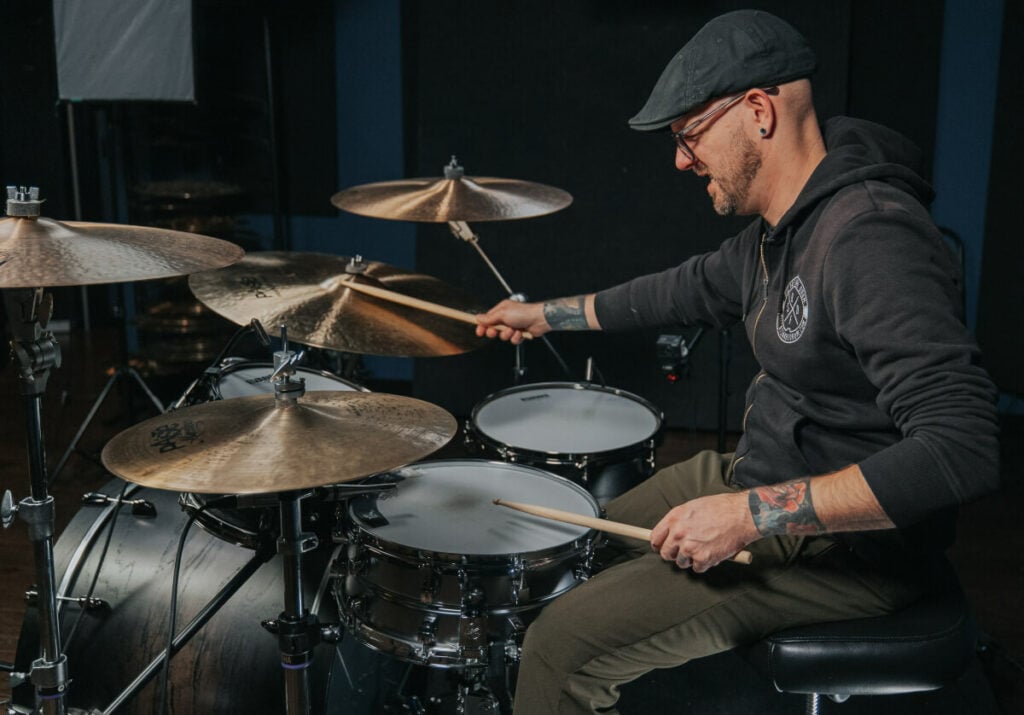
This article is a must-read for drum educators!
Playing-related musculoskeletal disorders (PRMDs) – also known as repetitive strain or overuse injuries – are injuries that develop over time as a result of playing the drums and are severe enough to affect your ability to play the drums at the level to which you are accustomed1. These kinds of injuries are very common in drummers2, and they can be particularly difficult for drummers to manage because of the risks involved in their career (e.g., precarious employment, pressure to always deliver peak performance, challenges with being able to take time off, etc.3), the high costs associated with these injuries4,5, and the lack of extended healthcare benefits to help offset the costs2. Effective strategies that will help prevent drummers from developing PRMDs in the first place are clearly needed to help reduce the burden of these injuries.
One strategy could be for drum instructors to teach their students about ergonomics/injury prevention (i.e., Prevention Education, or ‘PrevEd’ for short). In theory, if drum instructors included PrevEd in their teaching, it might encourage their students to engage in risk reduction behaviors (e.g., warming up, cooling down, taking breaks, and exercise), which in turn may reduce their rates of developing PRMDs and/or the severity of their symptoms. There is some research evidence that suggests this might work6-10, but none of it focused specifically on drummers, and drummers and/or percussionists were either included in very small numbers or not at all.

Luckily, when I designed my original survey study, I had included questions about whether the respondents had been taught anything about how to prevent PRMDs during their formal drum training, and if so, what were they taught. I went back to take another look at the data to see if there were any relationships between reporting PRMDs and receiving PrevEd.
Of the 831 drummers who participated in the study, 81% of them had taken formal lessons (the average reported duration of engaging in these lessons was 7 years). However, only 42% of those who took formal lessons had received PrevEd from their instructors.
Here’s where things got really interesting: drummers who had not received PrevEd were twice as likely to report having experienced a PRMD over the course of their lifetime than those who had, and they were almost twice as likely to report having experienced a PRMD within the seven days prior to completing the survey. They also engaged in warm-ups, cool-downs, and exercise significantly less often.
Drummers who had not received Prevention Education from their drum instructor were almost 2x as likely to report experiencing a PRMD.
The association between receiving PrevEd and reduced reporting of PRMDs held even when I divided up the group who had not received PrevEd so that I could look at the effect of formal lessons more closely.
So, what does all of this mean in practice? These findings suggest that teaching drum students PrevEd has the potential to be an effective way to reduce drummers’ risk of developing PRMDs. However, formal lessons alone may not be enough to make this happen – drum instructors need to discuss ergonomics and injury prevention specifically with their students if we want to reduce their risk of developing PRMDs. That said, this study also showed that even PrevEd is not a “magic bullet”. The rates of PRMDs were lower in drummers who did vs. did not receive PrevEd, but the rates in both groups were still pretty high overall. Similarly, the rates of engagement in PRMD prevention behaviours were higher in drummers who did vs. did not receive PrevEd, but the rates in both groups were still pretty low overall. This suggests that drummers might not be engaging in these behaviours regularly enough, or that their approaches to these behaviours may not be optimized, to really reap the benefits. For example, stretching will only be marginally helpful if you aren’t doing it often enough, or for the right amount of time, or doing it the right way (e.g., static vs. dynamic stretching) at the right time (before vs. after playing).
Understandably, teaching students about PrevEd and how to optimize their engagement in PRMD prevention behaviors could be a daunting task for drum instructors, especially if they were never taught anything about PrevEd themselves. Given that playing the drums is both an athletic and occupational activity, ergonomists and/or sports medicine professionals (e.g., athletic therapists, certified strength and conditioning coaches, etc.) would be great resources for drum instructors to consult to help them develop and/or optimize their PrevEd curricula. These professionals are also ideally suited to help drummers resolve existing PRMDs and reduce the chances that they will flare up again in the future. You can also refer to this article about how to recognize and manage the two most common PRMDs (tendinitis and carpal tunnel syndrome).
*Neither Drumeo nor Dr. Azar can provide medical advice. Please go see a medical professional if you’re concerned about something! The content of this article is meant to provide you with some food for thought and some information to help you ask the right questions of your medical team.
This article is a summary of the following research article:
Azar NR. Injury prevention education provided during formal drum kit training is associated with lower frequency reporting of playing-related musculoskeletal disorders. Journal of Popular Music Education. 2021; 5(2): 187-210. https://doi.org/10.1386/jpme_00057_1
Nadia Azar Ph.D. is an Associate Professor of Kinesiology at the University of Windsor, where she runs the Drummer Mechanics and Ergonomics Research Laboratory (DRUMMER Lab). Follow Nadia at @DrNadiaAzar or learn more here.


By signing up you’ll also receive our ongoing free lessons and special offers. Don’t worry, we value your privacy and you can unsubscribe at any time.
We use cookies for traffic data and advertising. Cookie Policy »